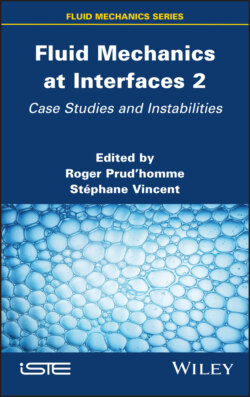Читать книгу Fluid Mechanics at Interfaces 2 - Группа авторов - Страница 5
Оглавление
Preface
Volume 2 of Fluid Mechanics at Interfaces, subtitled Case Studies and Instabilities, focuses on different kinds of interfaces and flow regimes in their vicinity. As with Volume 1, this book is born out of the systems and engineering e-journal, Thermodynamics of Interfaces and Fluid Mechanics1, which studied thin zones separating media with different properties. These include phase separation as well as thin flames and discontinuity waves. At the macroscopic level, they are compared to material surfaces endowed with thermodynamic properties with their related constitutive laws.
We recall that Volume 1, subtitled Methods and Diversity, consisted of six chapters: 1. Modeling Interfaces with Fluid Phase; 2. Simulations of Turbulent Two-Phase Flows with Phase Change Using a Multifield Approach Combined with LES; 3. An Original Approach to Extract Momentum and Heat Transfers from Particle-Resolved Simulations of Particulate Flows; 4. Interfaces and Critical Fluids; 5. Shear Induced Anomalies in the Brownian Motion of Particles in Strongly Fluctuating Near-Critical Mixtures; and 6. Basics on Interfaces in Combustion.
In Volume 2, we examine cases that involve 1D, 2D or 3D manifolds in gaseous and liquid physical states, supercritical fluids, and single- or multi-phase systems that may be pure or mixed. This volume also consists of six chapters, which are as follows:
Chapter 1 (J.-P. Caltagirone and S. Vincent) describes certain aspects of turbulence in discrete mechanics. The first part of this chapter is a brief description of the physical model associated with discrete primal and dual geometric topologies. The last section is devoted to simulating the turbulent channel flow with a turbulent Reynolds number of Reτ = 590.
Chapter 2 (R. Prud’homme) focuses on atomization in an acceleration field. The atomization of liquid jets injected into gaseous flows is an important problem that arises in combustion. It is especially important to know the size distribution of droplets to predict the evolution of the obtained sprays. In certain cases, an initial Kelvin–Helmholtz instability, created by vortices generating an acceleration field, becomes the source of a second instability known as the Rayleigh–Taylor instability, which determines the size of the droplets formed through this instability.
Chapter 3 (T. Chakkour) explores numerical studies of pipes with sudden contraction using OpenFOAM, and focuses on modeling that will be useful for engines and automobiles, bringing together models with 1D/3D couplings and revealing zones with strong gradients.
Chapters 4 (R. Prud’homme and K. Anani) and 5 (R. Prud’homme, K. Anani and M.N. Hounkonnou) study the evaporation of droplets subject to HF (high-frequency) perturbations, a possible cause of instabilities in injection engines. The Heidmann model, which replaces the droplets in motion in the combustion chamber by a single continuously fed droplet, is complexified by taking into account the finite conduction heat transfer phenomenon. This accentuates the damping of oscillations in the evaporation rate. We study the temperature field within the drop, as well as the response factor of a spherical drop to the high-frequency pressure field created by the engine. A pastille-shaped model of the drop is used, replacing the spherical drop, which makes it possible to go further with linearized calculations.
Finally, Chapter 6 (F. Raveloson, D. Tomboravo and R. Vony) presents the study of the interface, which is the surface of rotor blades in a Savonius wind turbine. A non-stationary and 3D flow is studied.
Roger PRUD’HOMME
Stéphane VINCENT
Christian CHAUVEAU
Mahouton Norbert HOUNKONNOU
November 2021
1 1 To consult these articles, see: https://www.openscience.fr/Thermodynamique-des-interfaceset-mecanique-des-fluides.
